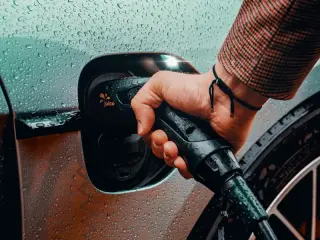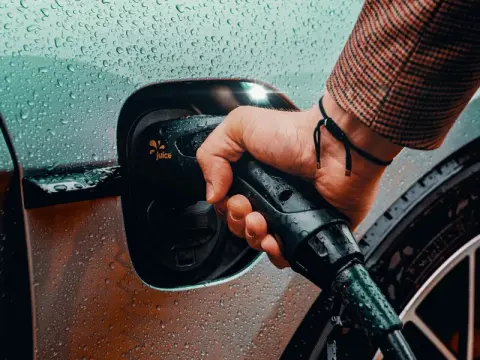
Electric vehicles (EVs) are becoming a bigger part of the UK’s roads and for good reason. They’re helping to cut carbon emissions, reduce air pollution, and push us closer to net zero. Fleets across the UK are seeking to decarbonise, and we’re supporting this journey with a range of EV charging solutions alongside our traditional fuel card services.
But, for many drivers, there’s still one thing holding them back: EV range anxiety.
If you’ve ever planned a trip and thought, “Will I have enough charge to get there and back?” or “What if I can’t find a charger in time?” you’ve felt it.
In short, EV range anxiety is the worry that your battery won’t last long enough to reach your destination, or worse, that your vehicle will be stranded far from a charger. For some, that worry is enough to cancel plans altogether. For others, it’s a constant niggle in the back of the mind.
But range anxiety is less of a barrier than it seems. In 2025, EVs and charging infrastructure have come a long way. In this post, we’ll explain what EV range anxiety is, what affects EV driving range, and how to overcome it so you and your drivers can stay confident behind the wheel.
What is EV range anxiety?
EV range anxiety is the fear that your EV won’t have enough battery charge to get you where you need to go or to the next charging point. It’s the worry that you’ll be stranded by the roadside with no available battery, unable to drive or that there won’t be a reliable charging station available when you need one. It’s a mix of psychological worry and real-world concern.
It’s one of the most common psychological barriers to switching to electric vehicles, even though most journeys in the UK are well within an EV’s range.
Around 99% of all car trips in the UK are under 100 miles, a distance every modern EV can manage on a single charge.
Is EV range anxiety justified?
The answer to this question is complex. It’s a less justified fear than it was a few years ago, thanks to advances in EV battery technology, the UK public charging network and EV software.
The good news is that EV range and charging infrastructure have made significant progress in recent years. Public charging stations are increasing every year, and battery technology is improving at an impressive pace. In fact, in August 2025, the Polestar 3 broke the world record for the longest distance on a single charge, an incredible 581.3 miles.
However, the number of petrol stations still far outstrips the number of public chargers. As of April 2025, the UK had around 462,000 battery electric vehicles (BEVs) on the road and roughly 85,000 public charging stations. While the gap is closing, it’s understandable why some drivers still feel nervous.
Here’s some more evidence:
Many modern EVs now routinely exceed 200–300 miles of real-world range.
In the UK, thousands of new public charging points come online every year, including rapid chargers.
A recent survey found that 58% of EV drivers are confident to plan long-distance journeys, and only a minority frequently experience range anxiety.
Still, range anxiety doesn’t disappear entirely, especially for fleets covering long routes, operating in rural zones, or managing older EVs with degraded batteries.
What factors affect EV driving range?
Even the most advanced EVs have factors that can shorten their range. Here are the main ones to watch out for:
Speed – Driving over 65mph reduces efficiency because your motor must work harder to push through air resistance.
Wind – Strong headwinds create drag, making the motor work harder and draining the battery faster.
Weight & payload – The heavier the load, the more energy the motor needs to move the vehicle, especially on inclines.
Tyre traction & pressure – Poor-quality tyres, low tread, or incorrect pressure can all increase rolling resistance and reduce range.
Cold weather – EV batteries prefer moderate temperatures. In cold weather, they use extra energy to warm up and maintain optimal operating temperature. Unlike petrol engines, EVs can’t reuse waste heat; they have to generate it from the battery.
Heating & air conditioning – Cabin heating and cooling draw energy directly from the battery. In an ICE vehicle, waste engine heat can be repurposed for cabin warmth. In an EV, heating requires extra energy output.
Battery health – Over time, EV batteries lose some capacity (known as degradation). Thanks to thermal management systems, most modern EVs lose range slowly, but it’s still a factor to keep in mind.
For more on battery lifespan, check out our guide: How Long Do Electric Vehicle Batteries Last?
How to overcome EV range anxiety
The good news? Range anxiety can be tackled with some simple habits:
Plan ahead – Before a long trip, map out your route and locate charging stations along the way. Apps like Zapmap or your EV’s built-in navigation can make this quick and easy.
Charge while parked – If you’re stopping for lunch, a meeting, or an overnight stay, choose a spot with charging facilities. This way, you’re topping up without adding extra time to your journey.
Install a home charger – A dedicated home charging point means you start every day with a full battery, no more last-minute charging worries.
Driving training & incentives – Educate drivers about eco-driving. Smooth acceleration, moderate speeds, and avoiding harsh braking all help your battery go further. You can read more in our guide to Best Practices for Efficient and Safe EV Charging.
Battery & vehicle maintenance – Keep batteries within ideal operating ranges, schedule health checks, and manage charging habits to slow degradation.
EV range anxiety: the bigger picture
While anxiety is declining, infrastructure gaps and public perception remain hurdles.
Authorities, charging network providers, and manufacturers must continue investing in:
More rapid+ ultra-rapid chargers along key routes.
Real-time charger status systems (availability, pricing, queueing).
Advances in megawatt charging and next-generation battery tech to allow 400–500+ mile range boosts.
Range anxiety isn’t just about battery size; it’s about confidence, trust in infrastructure, and removing friction in everyday charging.
The bottom line: what EV range anxiety means for fleets
EV range anxiety is real, but it’s much less of a threat than before, and most EV drivers find that it fades quickly with experience. By understanding what affects your vehicle’s range and planning smartly, you can turn those “what if?” worries into confident, stress-free journeys.
For fleets considering electrification, it’s important to manage the risks and obstacles to help you achieve EV adoption to support your decarbonisation plan, and deploy smart tools to mitigate them.
For your fleet:
Evaluate whether your routes and operations are suitable for EV deployment now.
Use hybrid fuel card solutions so EVs and fuel vehicles can coexist.
Plan and train around real-world constraints.
Monitor battery health, usage patterns, and charging infrastructure.
And if you’re looking to make charging even simpler for your drivers, we offer a range of smart EV charging solutions that are tailored to help businesses of all sizes make the switch to electric vehicles.




